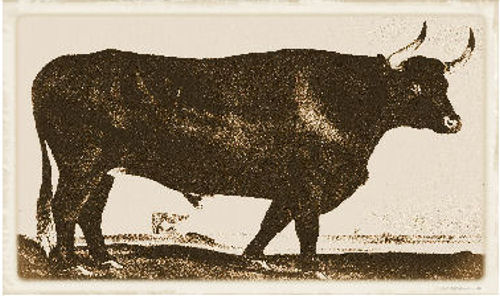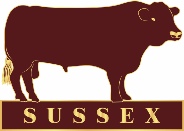
SUSSEX PAST
It is always difficult to trace the origin of any breed of livestock, so few records having been kept prior to the eighteenth century, but it is commonly agreed that Sussex Cattle are one of our oldest breeds, having inhabited the Weald of Sussex and Kent from time immemorial.
Professor Robert Wallace wrote that the Sussex belong to the old race believed to have given origin more or less directly to the West Highland, Welsh, Hereford and Devon breeds, and that the dense forests of the Weald afforded the necessary security for the ancestors of the breed. Although more recent advances in genetic studies indicate that the Sussex are not connected closely to any other breed.
The Sussex has been an English breed for hundreds of years, and has developed its special characteristics on
soil on which it has been raised for a lengthy period of time, and under conditions which have confirmed its inherent good qualities. It is on account of its ancient lineage that Sussex Cattle are so prepotent and stamp their qualities in no uncertain fashion, while as from the first the colour has always been a mahogany red, this colour does not vary, and is dominant in calves sired by a Sussex bull from other cows.
Originally, and for many generations, the Sussex were a draught breed, and it is from the result of hard work in the plough, the wagon, and in the timber tugs that they attained their hardy constitutions, and a frame of such symmetrical proportions that when steers of the breed had finished with the yoke it was little or no trouble to feed them to great weights of excellent beef.
As long ago as the years in which George Culley was describing the famous breeds of the Kingdom, he spoke
of Sussex Cattle as being recognised to be one of the best moving breeds for draught purposes in England.
Professor James Long, in an article on Sussex Cattle in The Encyclopedia of Modern Agriculture, quotes Lord Sheffield as writing at the end of the 18th century that a Sussex ox, on one occasion, travelled over the four-
Defoe, in his work A Tour of Great Britain, in 1724, has placed it on record that he saw a tree drawn on a timber-
It will be realised, therefore, that from early days in its known history Sussex Cattle have been noted for their working abilities and for their hardy constitution. Practically all work on the land and in the woods was carried out by the aid of Sussex oxen, and until late in the 1900′s there were still a few plough teams of the breed to be seen in the Lewes area.
Mr. Henry Rigden, in his article on the breed in the Journal of the Royal Agricultural Society for 1908, says:
“Early in the 18th century the Wealds of Kent and Sussex were the centre of the great iron industry and the extensive forest of Anderida was denuded of its oaks to feed the large furnaces of Mayfield, Lamberhurst, and other places in the district.”
“The strong boned Sussex steers were particularly well adapted for the haulage of this timber through the soft undrained tracks of the partially cleared forest.”
Up to 1906, on the Lyne estate, Sussex oxen had been used for ploughing, carting and timber hauling and they were sold at Tenterden, Kent.
As late as 1889 the late Mr. W.W. Chapman wrote that he had seen a team of draught oxen coming out of the big woods near Robertsbridge, Ticehurst, and Wadhurst.
Then Mr. William Wood, than whom no one knew more about Sussex agriculture, wrote:
“For the purpose of breeding working oxen I can
conceive no breed of cattle whose impress is likely to be so marked upon native stock, already stamped by use and selection with draught properties, as the Sussex.
Bred for centuries for no end but to work as long as they would earn a living, and to be slaughtered for food afterwards; with powers of endurance and a character for staunchness unequalled by any horse in the world; possessing hardihood and activity combined with weight and constitution, when the Africander sees a Sussex bull, or better still his progeny, our herds will be too small to supply the demand which cannot fail to spring up.”
It is of great interest to follow Arthur Young’s tour in Sussex round about 1795, and to learn what he thought of Sussex Cattle; that he was greatly impressed is proved by his statement that they must be ranked amongst the best in the Kingdom; that Sussex breeders’ ideas ran strongly in favour of a dark red colour; and that the Sussex are as remarkable for the fineness of their hides as they are for the closeness and delicacy of their flesh.
Young was concerned to know the methods employed by farmers to fatten their cattle. He quoted the case of Mr. Bridger, of Tillington, who soiled his cattle in summer upon clover and tares, till the rouen was ready, which was the end of July, and held until the beginning of November. Then he took them into yards and fattened them upon
barley and linseed, mixed and ground together: two pecks of linseed to two bushels and a half of barley, and wheat-
This food was also used in large quantities by Lord Egremont at Petworth, who fatted his Sussex oxen on these rations.
Young stated that Sussex men bred their beasts with weight before as well as behind in equal proportions. Instead of being light and narrow, Sussex cattle were broad and weighty, and good Sussex thrivers filled up with meat all over.
Smithfield was the great market for the sale of fat Sussex beasts, where they were deservedly held in the highest estimation.
Graziers catered especially for the period from Christmas to May, when prime beef was keenly in demand.
The average weight of these Sussex cattle was about 140 stone.
It is recorded, however, that Mr. Edsaw, of Fittleworth, specialised in the breeding of large Sussex oxen, and he had them six feet high behind, and five and a half before, and six feet and a half girth over the heart. They sometimes were slaughtered up to 216 stone, when eight years old.
Mr. Ellman, of Shoreham (son of the great John Ellman, of Glynde), fed one which had the following measurements:
- Length from crown to rump 9 ft 6 ins
- Girth before shoulders 9 ft 5 ins
- Girth behind shoulders 9 ft 0 ins
- Girth round the middle 10 ft 0 ins
- Length from nostrils to tip of tail-
bone 14 ft 8 ins - Length of solid sides 6 ft 7 ins
This steer was seven years old and weighed 214 stone.
Perhaps the largest Sussex ox known in the breed was that bred at Burton Park, which was 161 hands high, 10 feet girth behind the shoulders and scaled 287 stone 4 lbs.
Writing on the Sussex cow as a milk producer, Young pointed out that their milking abilities were a secondary consideration, but that they kept themselves almost in beef condition while they were giving milk.
On Lord Hampden’s estate at Glynde, a Sussex cow two or three weeks after calving gave 10 lbs. of butter per week for some weeks, and the next year she gave 9 1/2 lbs. per week for some time.
That summer cheese was also made from her milk, about 6 lbs. each in weight, when she gave most milk two were made per week, so that at the height of milking she gave 10 lbs. of butter and 12 lbs. of cheese per week.
This cow never at any time gave more than five gallons of milk per day.
Cobbett, when on his famous Rural Rides, mentioned the Sussex breed in 1823, thus:
“In quitting Appledore I crossed a canal and entered on Romney Marsh. This was grassland on both sides of me to a great distance. The flocks and herds immense. The sheep are of a breed that takes its name from the marsh. They are called Romney Marsh sheep. Very pretty and large. The wethers, when fat, weigh about twelve stone, or one hundred pounds. The faces of these sheep are white, and, indeed, the whole sheep is as white as a piece of writing paper. The
wool does not look dirty and oily like that of other sheep.”
“The cattle appear to be all of the Sussex breed. Red, loose-
Those were the days when Sussex Cattle held sway throughout the Weald and the Marshlands; but even then there were signs of herds being dispersed.
The late Mr. William Wood, junior, wrote:
“Up to the end of the 18th century a large proportion of the land (in the Weald) was old pasture, and on nearly all farms there was a herd of Sussex Cattle, but during the Napoleonic Wars, when wheat was at a very high price, the farmers in the Weald within reach of market and farming their own land were tempted to break up the pastures and grow wheat;
. . . The price of wheat went back after these wars when peace prevailed; our farmers had parted with their cattle, their chief asset, and gradually dwindled and disappeared as misfortune overtook them when the cultivation of this stiff land became unprofitable.
In East Sussex these breeding herds did not disappear, partly for the reason that the -
Sussex cattle were bred there in large numbers after they had disappeared from the Weald.
They are to some extent still bred there.”
This was written in 1938; and one can imagine the pleasure it would have given Mr. Wood could he have lived to see the great revival of the breed which is taking place today.
Probably the oldest herd of Sussex surviving today is the Petworth Herd known to have existed in 1782 and mentioned by Arthur Young in 1793. We also understand that the current “Wright” herd, of East Guldeford, Rye, is descended from the Sussex that worked on the farm as draught animals.
THE HERD BOOK
Sussex Cattle, became so popular as an early maturing beef breed, and so numerous were the herds that the most progressive breeders felt the time had come to found a Breed Society and to publish a Herd Book.
Thus on 18th November, 1878, a public meeting, was held at The King’s Head, Horsham, for the purpose of considering and promoting the future management of the Sussex Herd Book and The Sussex Herd Book Society was formed for promoting the breed of Sussex Cattle.
It was in June 1879, that the first volume of the Herd Book was published, containing entries of Sussex Cattle from 1855 to 1875. It contained the names of breeders and the cattle entered, the pedigrees of the animals and the prizes they had won.
The first annual sale of Registered Sussex Bulls, was held on 16th February, 1888, under the auspices of the Society.
SUSSEX CATTLE SOCIETY
